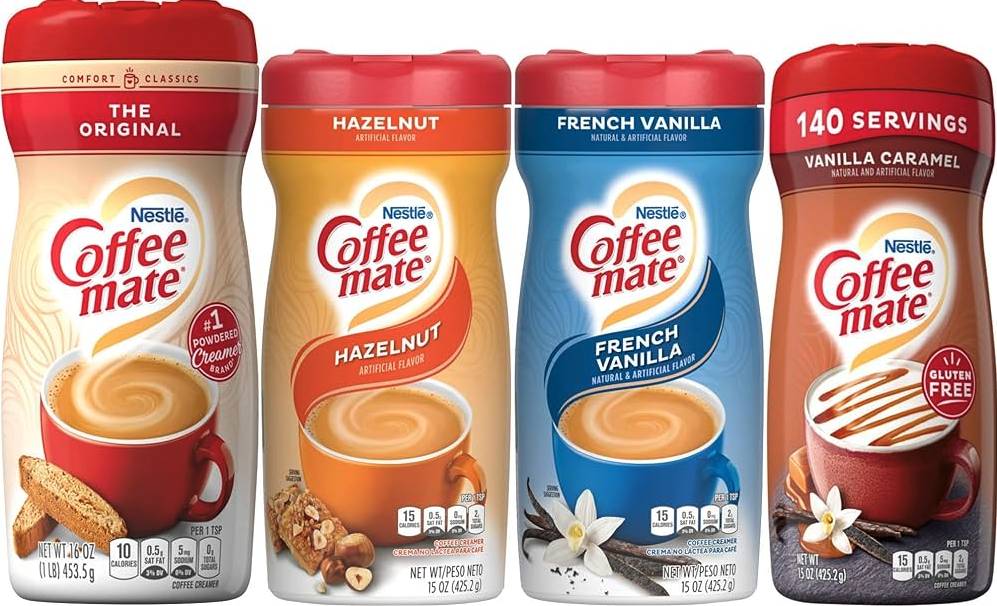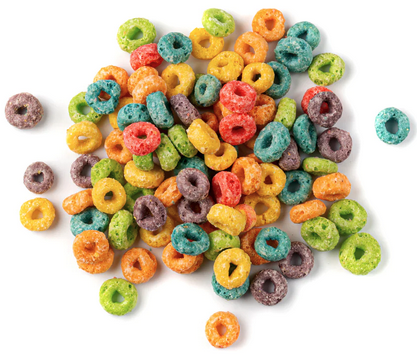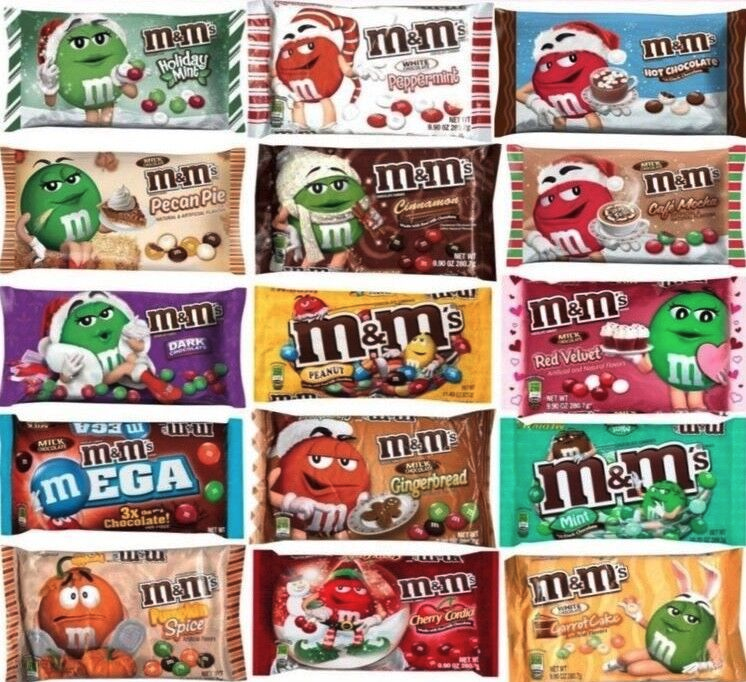When Joe and I travel overseas, one of my guilty pleasures is visiting supermarkets and grocery stores. Food is such a common thing for people worldwide, even if we don’t all eat the same thing. So I always love to see all the things in Tesco, Lawson’s, Woolworth’s Supermarket, etc. – both brands and actual items – that we generally don’t have.
I also enjoy seeing all the products from the U.S. that have made it to other places. Heinz Ketchup. Kellogg’s cereals. I remember it took forever for Reese’s Peanut Butter Cups to make it to the UK but eventually got there 😉
That being said, there are bunches of U.S. products that never, ever make it to select foreign countries. Most of the time it’s because the U.S. rules for food products are more lax than the other countries in question. Here are some of them:
Coffee Mate
 Introduced by Carnation in 1961, Coffee Mate is great in a pinch, when you want your coffee to be creamy. However to help make that cup o’joe creamy, Coffee Mate is made with hydrogenated soybean and cottonseed oil. Both ingredients are banned in Austria, Denmark, Iceland, Iceland, Norway and Switzerland, among others, because they’ve been linked to heart disease. So you won’t find any Coffee-Mate there.
Introduced by Carnation in 1961, Coffee Mate is great in a pinch, when you want your coffee to be creamy. However to help make that cup o’joe creamy, Coffee Mate is made with hydrogenated soybean and cottonseed oil. Both ingredients are banned in Austria, Denmark, Iceland, Iceland, Norway and Switzerland, among others, because they’ve been linked to heart disease. So you won’t find any Coffee-Mate there.
Froot Loops
 American kids have been eating Froot Loops (it was originally called Fruit Loops, but people sued because there’s NO fruit in those loops) since the late 1950s. But they don’t eat them in Norway, Finland, Austria, France, and the U.K. because the product has been banned, due to the massive amounts of artificial dyes used in the cereal (and the same goes for Fruity Pebbles, by the way) that can inhibit nerve-cell development.
American kids have been eating Froot Loops (it was originally called Fruit Loops, but people sued because there’s NO fruit in those loops) since the late 1950s. But they don’t eat them in Norway, Finland, Austria, France, and the U.K. because the product has been banned, due to the massive amounts of artificial dyes used in the cereal (and the same goes for Fruity Pebbles, by the way) that can inhibit nerve-cell development.
M&Ms
 You can easily find M&Ms around the world. But you won’t find AMERICAN M&Ms in Europe, because they’re banned. Again, because of food coloring. Our blue M&Ms contain blue dye #2, which has been proven to cause tumors in rats.
You can easily find M&Ms around the world. But you won’t find AMERICAN M&Ms in Europe, because they’re banned. Again, because of food coloring. Our blue M&Ms contain blue dye #2, which has been proven to cause tumors in rats.
FUN FACT! Red M&Ms were discontinued in the U.S. for a decade. Here’s why.
Maraschino Cherries
Food dye strikes again! This time it’s red dye #40. Besides being used in maraschino cherries, it’s also found in grenadine and cherry pie mix.
Red dye #40 causes allergic reactions in many people and also puts you at increased risk of cancer. So it’s banned in Norway, Finland, France, Austria, the U.K., and several other European countries.
Frozen Dinners
Azodicarbonamide can be found in a variety of things, including frozen dinners (as well as bread, boxed pasta mixes, and packaged baked goods. NPR reported in 2014 that it was found in over 500 food items). It’s a chemical substance approved for use as a whitening agent in cereal flour and as a dough conditioner in bread baking.
It’s also used in foamed plastics, such as yoga mats and the soles of sneakers. Tests have determined that it can induce asthma. Anything containing azodicarbonamide is banned in Australia, the United Kingdom, and most European countries.
Fat-Free Snacks
Back in the mid-late 90s, Olestra was considered a great invention. You could eat potato chips and not gain weight because they had no oil in them – they had Olestra instead, and it added no calories to the foods!
THEN people began to realize that if you ate too much Olestra (which was found in fat-free potato chips, corn chips, French fries, crackers and cookies), it could cause major gastrointestinal distress, including cramps and leaky bowels. It also makes your body unable to absorb vitamins. So products containing Olestra are banned in Canada and the U.K.
As of 2023, no products containing Olestra are produced in the United States. But there are still some left over that still haven’t reached their expiration date.
Artificial Blueberry
Do you like blueberry-flavored NutriGrain bars? How about blueberry Pop Tarts? If you want to eat them in Norway, Finland, Austria, France, and the U.K., you best bring a few boxes of the stuff with you because they’re illegal to sell in those countries.
The blue dye NutriGrain and Pop Tarts use to make the stuff blue is derived from petroleum. You know, that stuff they use to make gasoline, diesel fuel, asphalt and tar. It’s also been linked to nerve-cell degeneration, brain cancer, and hyperactivity.
Boxed Macaroni and Cheese
Many, MANY food items in the U.S. have food dye to make them look more appealing. Boxed macaroni and cheese is a prime example, with many brands using yellow #5 and #6. These food additives are banned in Austria, Norway, and a few other European countries because it’s believed they can cause hyperactivity, increased cancer risk, and allergic reactions.
FUN FACT! One of the most popular brands of macaroni and cheese in the U.S., Kraft Macaroni & Cheese, is indeed sold in Europe, but the ingredient list is significantly different. Take a look:
U.S. Version of Kraft Mac & Cheese:
Enriched Macaroni Product (Wheat Flour, Niacin, Ferrous Sulfate [Iron], Thiamin Mononitrate [Vitamin B1], Riboflavin [Vitamin B2], Folic Acid), Cheese Sauce Mix (Whey, Modified Food Starch, Whey Protein Concentrate, Cheddar Cheese [Milk, Cheese Culture, Salt, Enzymes], Salt, Calcium Carbonate, Potassium Chloride, Contains Less Than 2% of Parmesan Cheese [Part-Skim Milk, Cheese Culture, Salt, Enzymes, Dried Buttermilk, Sodium Tripolyphosphate, Blue Cheese [Milk, Cheese Culture, Salt, Enzymes], Sodium Phosphate, Medium Chain Triglycerides, Cream, Citric Acid, Lactic Acid, Enzymes, Yellow 5, Yellow 6).
U.K. Version of Kraft Mac & Cheese:
Macaroni (Durum Wheat Semolina), Cheese (10%), Whey Powder (from milk), Lactose, Salt, Emulsifying Salts (E339, E341), Colours (Paprika Extract, Beta-Carotene)
Want to comment on this post? Great! Read this first to help ensure it gets approved.
Want to sponsor a post, write something for Your Mileage May Vary, or put ads on our site? Click here for more info.
Like this post? Please share it! We have plenty more just like it and would love it if you decided to hang around and sign up to get emailed notifications of when we post.
Whether you’ve read our articles before or this is the first time you’re stopping by, we’re really glad you’re here and hope you come back to visit again!
This post first appeared on Your Mileage May Vary

2 comments
Which version of Mac ‘n Cheese would you rather eat. My vote goes for the UK version which contains things I can largely pronounce. The US version appears to come from some form of poisoner’s experimental lab.
Frankly, I’d prefer to eat the non-US version of virtually anything. But as someone living in the US, I don’t have much choice.